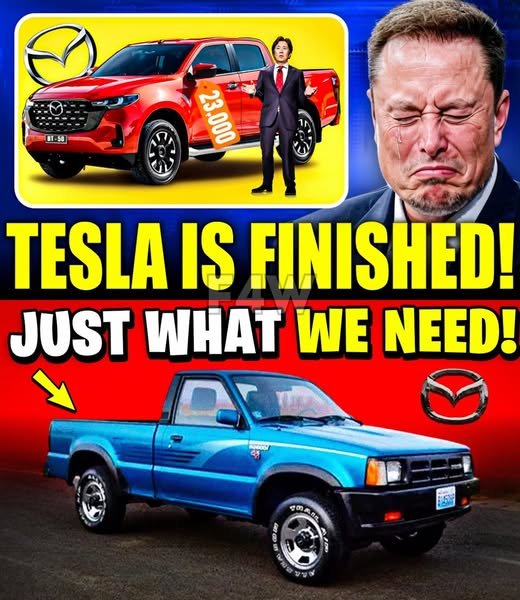In a bold and provocative move that has ignited heated debate across the automotive world, Mazda’s CEO recently unveiled a new pickup truck priced at just $23,000-a price point and feature set that many say “obliterates” Tesla’s much-hyped Cybertruck. This announcement has sent shockwaves through Tesla’s fanbase and investors, raising serious questions about the future of electric trucks and the viability of Tesla’s disruptive but controversial design and pricing strategy.
Mazda, a brand long known for its sleek design, reliability, and efficient engineering, is now stepping aggressively into the midsize truck market with a vehicle that blends power, style, and affordability. The new Mazda pickup boasts a rugged yet elegant exterior featuring the signature Kodo design language, sharp LED headlights, and muscular lines that command attention both on and off the road. Unlike Tesla’s Cybertruck, which has polarized opinion due to its angular, futuristic look, Mazda’s truck appeals to traditionalists who want a truck that looks tough but refined.
Under the hood, Mazda offers multiple engine options, including a 2.5-liter turbocharged engine producing around 250 horsepower for everyday driving and a 3.0-liter diesel engine delivering 310 horsepower and 400 lb-ft of torque for heavy-duty tasks. The truck can tow up to 7,500 pounds and haul a payload of 1,800 pounds, making it a serious contender for work and play. Inside, the cabin is luxurious and tech-savvy, featuring a 12.3-inch touchscreen infotainment system with Apple CarPlay and Android Auto, plus advanced safety features like adaptive cruise control and lane-keeping assist. All this comes at a starting price of just $23,000, with fully loaded models still undercutting the Cybertruck’s price tag by thousands.
Tesla’s Cybertruck, despite its futuristic design and electric powertrain, has faced criticism for its high price-starting around $39,900-and production delays. Its polarizing aesthetics and stainless steel exterior have divided consumers, with many skeptical about its practicality and comfort. Moreover, Tesla’s reliance on electric-only powertrains contrasts sharply with Mazda’s more traditional, combustion-based engines, which some argue still offer more reliability and convenience in today’s infrastructure.
This clash has sparked a fierce debate: Is Tesla’s Cybertruck truly the future of trucks, or is Mazda’s affordable, powerful, and stylish pickup a more sensible choice for mainstream buyers? Critics of Tesla argue that the Cybertruck’s niche appeal and high cost limit its market potential, while Mazda’s entry could redefine the midsize truck segment by offering a balanced package that combines performance, comfort, and value.
On the other hand, Tesla supporters claim that Mazda’s combustion engines are outdated in an era demanding sustainability and electrification. They argue that Tesla’s electric powertrain, autopilot features, and over-the-air updates represent the inevitable future of automotive innovation, which Mazda’s new truck simply cannot match.
The controversy deepens when considering the broader implications. Mazda’s aggressive pricing and traditional approach might appeal to consumers wary of electric vehicles’ range anxiety and charging infrastructure limitations. Meanwhile, Tesla’s vision pushes the industry toward a cleaner, more autonomous future, albeit with growing pains and market risks.
In conclusion, Mazda’s unveiling of a $23,000 pickup truck that challenges Tesla’s Cybertruck is more than a product launch-it’s a direct challenge to Tesla’s dominance and vision. This development forces consumers, investors, and industry watchers to reconsider what the future of trucks should look like: a bold, electric revolution led by Tesla, or a pragmatic, affordable, and stylish alternative from Mazda. The debate is far from settled, but one thing is clear-Tesla’s worst nightmare might just be the rise of a traditional automaker with a disruptive price and performance formula. The battle for the future of trucks has only just begun.



